MiG-21MFN
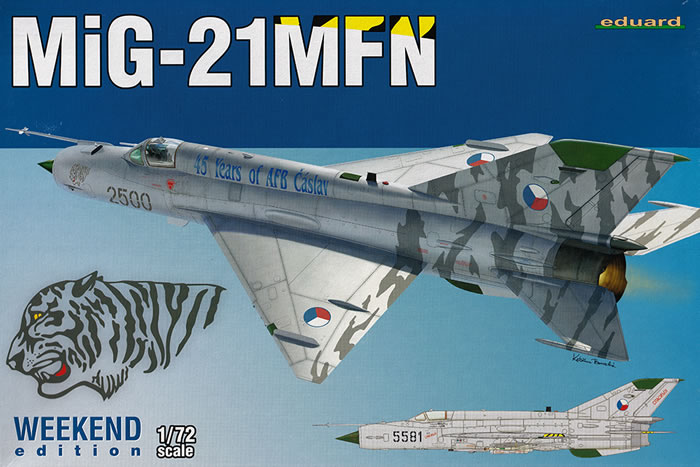
Eduard Weekend Edition, 1/48 scale
S
u m m a r y |
| Catalogue Number and Price: |
Eduard Kit No. 7452 - MiG-21MFN Weekend Edition
USD$22.95 plus shipping available online from Eduard
GBP£13.20 EU Price (£11.00 Export) plus shipping available online from Hannants
|
| Scale: |
1/48 |
| Contents and Media: |
Three grey injection moulded sprues containing 186 parts, 15 clear parts on 1 clear sprue, 6 Brassin cast resin parts, 1 set of brass photoetched metal parts (11 parts), 2 sheets of decals, 20 page instruction booklet |
| Review Type: |
FirstLook |
| Advantages: |
A kit with crisp yet subtle moulding with high level of detail, Eduard’s usual high quality instructions. Brassin resin parts and etched parts are a great extra, as are the 2 great schemes offered. |
| Disadvantages: |
|
| Conclusion: |
A chance to add some well detailed and interesting Tiger schemes to the cabinet for those modellers wanting that little bit extra. Wonderful kit! |
Reviewed by David Couche

MiG-21MF
The Mikoyan-Gurevich MiG-21 (NATO reporting name: Fishbed) is a supersonic jet fighter and interceptor aircraft, designed by the Mikoyan-Gurevich Design Bureau in the Soviet Union. It was popularly nicknamed "balalaika", from the aircraft's planform-view resemblance to the Russian stringed musical instrument or o?ówek (English: pencil) by Polish pilots due to the shape of its fuselage. It was also nicknamed "Én b?c" (In English: Silver swallows) by North Vietnamese, now Vietnam People's Air Force, pilots and the Vietnamese people.
Approximately 60 countries over four continents have flown the MiG-21, and it still serves many nations six decades after its maiden flight. It made aviation records, became the most-produced supersonic jet aircraft in aviation history, the most-produced combat aircraft since the Korean War and previously the longest production run of a combat aircraft (now exceeded by both the McDonnell Douglas F-15 Eagle and General Dynamics F-16 Fighting Falcon).
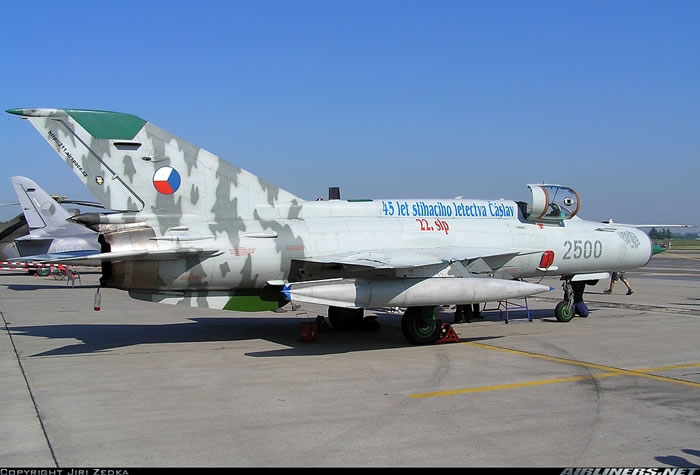
The MiG-21 jet fighter was a continuation of Soviet jet fighters, starting with the subsonic MiG-15 and MiG-17, and the supersonic MiG-19. A number of experimental Mach 2 Soviet designs were based on nose intakes with either swept-back wings, such as the Sukhoi Su-7, or tailed deltas, of which the MiG-21 would be the most successful.
Development of what would become the MiG-21 began in the early 1950s, when Mikoyan OKB finished a preliminary design study for a prototype designated Ye-1 in 1954. This project was very quickly reworked when it was determined that the planned engine was underpowered; the redesign led to the second prototype, the Ye-2. Both these and other early prototypes featured swept wings. The first prototype with delta wings as found on production variants was the Ye-4. It made its maiden flight on 16 June 1955 and its first public appearance during the Soviet Aviation Day display at Moscow's Tushino airfield in July 1956.
The MiG-21 was the first successful Soviet aircraft combining fighter and interceptor characteristics in a single aircraft. It was a lightweight fighter, achieving Mach 2 with a relatively low-powered afterburning turbojet, and is thus comparable to the American Lockheed F-104 Starfighter and Northrop F-5 Freedom Fighter and the French Dassault Mirage III. Its basic layout was used for numerous other Soviet designs; delta-winged aircraft included Su-9 interceptor and the fast E-150 prototype from MiG bureau while the mass-produced successful front fighter Su-7 and Mikoyan's I-75 experimental interceptor combined a similar fuselage shape with swept-back wings. However, the characteristic layout with the shock cone and front air intake did not see widespread use outside the USSR and finally proved to have limited development potential, mainly because of the very small space available for the radar.
Like many aircraft designed as interceptors, the MiG-21 had a short range. This was exacerbated by the poor placement of the internal fuel tanks ahead of the centre of gravity. As the internal fuel was consumed, the center of gravity would shift rearward beyond acceptable parameters. This had the effect of making the plane statically unstable to the point of being difficult to control, resulting in an endurance of only 45 minutes in clean condition. This can be somewhat countered by carrying fuel in external tanks closer to the centre of gravity. The Chinese variants somewhat improved the internal fuel tank layout (also second generation of Soviet variants), and also carry significantly larger external fuel tanks to counter this issue. Additionally, when more than half the fuel was used up, violent manoeuvres prevented fuel from flowing into the engine (questionable), thereby causing it to shut down in flight. This increased the risk of tank implosions (MiG-21 had tanks pressurized with air from the engine's compressor), a problem inherited from the MiG-15, MiG-17 and MiG-19. The short endurance and low fuel capacity of the MiG-21F, PF, PFM, S/SM and M/MF variants—though each had a somewhat greater fuel capacity than its predecessor—led to the development of the MT and SMT variants. These had an increased range of 250 km (155 mi) compared to the MiG-21SM, but at the cost of worsening all other performance figures, such as a lower service ceiling and slower time to altitude
The delta wing, while excellent for a fast-climbing interceptor, meant any form of turning combat led to a rapid loss of speed. However, the light loading of the aircraft could mean that a climb rate of 235 m/s (46,250 ft/min) was possible with a combat-loaded MiG-21bis, not far short of the performance of the later F-16A. Given a skilled pilot and capable missiles, it could give a good account of itself against contemporary fighters. Its G-limits were increased from +7Gs in initial variants to +8.5Gs in the latest variants. It was replaced by the newer variable-geometry MiG-23 and MiG-27 for ground support duties. However, not until the MiG-29 would the Soviet Union ultimately replace the MiG-21 as a maneuvering dogfighter to counter new American air superiority types.

The MiG-21 was exported widely and remains in use. The aircraft's simple controls, engine, weapons, and avionics were typical of Soviet-era military designs. The use of a tail with the delta wing aids stability and control at the extremes of the flight envelope, enhancing safety for lower-skilled pilots; this in turn enhanced its marketability in exports to developing countries with limited training programs and restricted pilot pools. While technologically inferior to the more advanced fighters it often faced, low production and maintenance costs made it a favourite of nations buying Eastern Bloc military hardware. Several Russian, Israeli and Romanian firms have begun to offer upgrade packages to MiG-21 operators, designed to bring the aircraft up to a modern standard, with greatly upgraded avionics and armaments.
A total of 10,645 aircraft were built in the USSR. They were produced in three factories: AZ 30[N 1] (3,203 aircraft) in Moscow (also known as MMZ Znamya Truda), GAZ 21 (5,765 aircraft) in Gorky [N 2] and TAZ 31 (1,678 aircraft) in Tbilisi. Generally, Gorky built single-seaters for the Soviet forces. Moscow constructed single-seaters for export, and Tbilisi manufactured the twin-seaters both for export and the USSR, though there were exceptions. The MiG-21R and MiG-21bis for export and for the USSR were built in Gorky, 17 single-seaters were helmed in Tbilisi (MiG-21 and MiG-21F), the MiG-21MF was first constructed in Moscow and then Gorky, and the MiG-21U was built in Moscow as well as in Tbilisi.
Text mostly from Wikipedia
A sturdy Eduard box opens to 3 sprues of grey injected moulded, finely detailed parts with 186 parts on them which enables you build a very nicely detailed model There is a clear sprue, containing 15 very clear parts, a small sheet of brass photo, decals for 2 different Tiger marked aircraft and 2 sheets of decals complete with one of these sheets being stencils and the usual comprehensive instruction booklet. All sprues are cleanly moulded with no flash evident, although a few of the parts exhibit some degree of moulding lines and sprue gates to the parts appear to have been created to minimise their effect on the parts. All in all, a good amount of plastic, resin and etch to play with.
Sprue A

Sprue A is the airframe sprue for the MiG-21MFN. The sprue has 17 grey injected moulded parts of which 3 are not used. Found here are the wonderfully detailed fuselages, wings, tailplanes, one piece spine and rudder and the tail cone
Sprue C
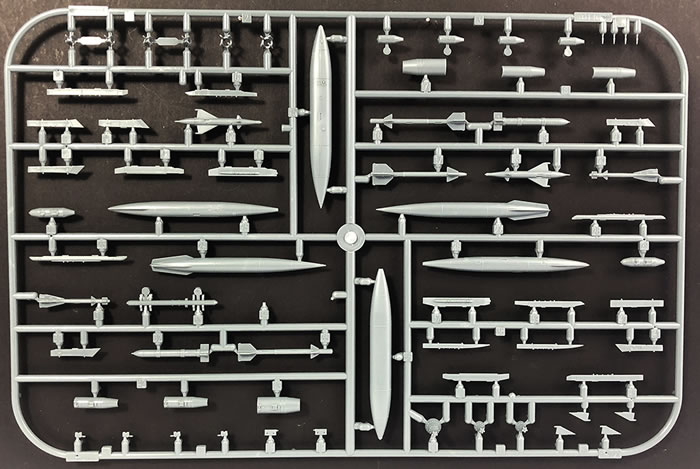
This sprue offer up 71 parts, which are the ordinance parts, which enables you to build a great range which includes the following:
Okay… impressed with this list you then find out that 50 of these parts are not used with either of these schemes. These aircraft generally only flew with either of the drop tanks and/or the R-13 or R-60 missiles. This will certainly boost the quantity in your spares box as well as the quality. Eduard does give you a typical load out guide for these specific aircraft but also recommends fitting out to your references. There will be plenty of building in assembling and finishing this array.
Sprue D
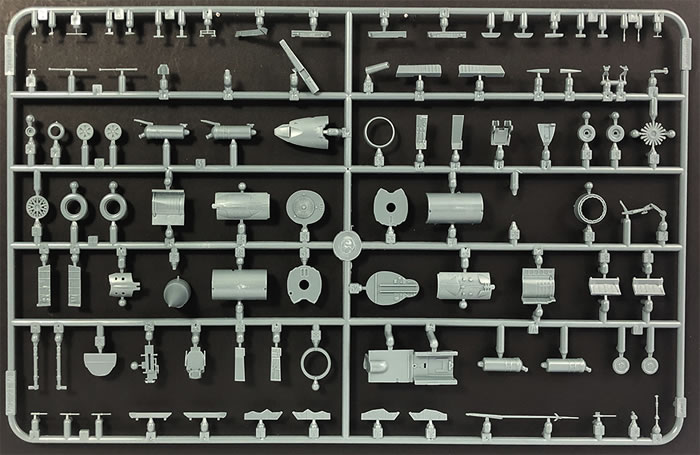
A sprue of some 98 parts with 8 unused, Sprue D has the cockpit parts, wheel bays, undercarriage parts, air brake, RATO units and a myriad of small pieces to be added to the airframe. All of the parts are beautifully detailed with both rivet detail and raised surfaces as required. Nice job Mr Eduard.
Sprue E
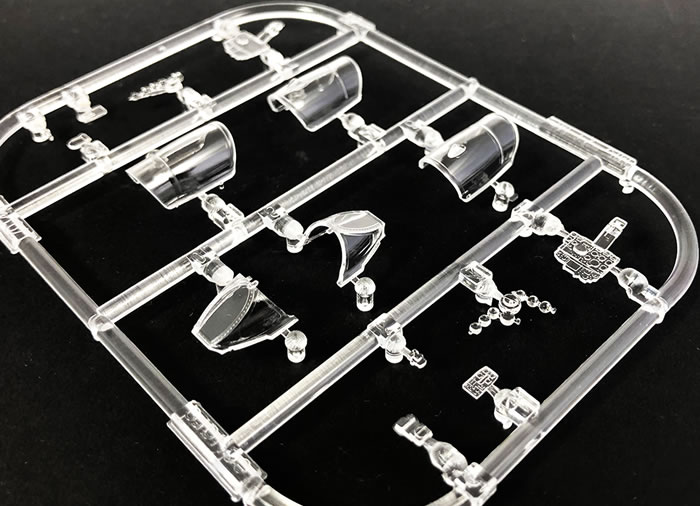
This sprue is clear sprue and provides 15 clear parts of which 5 are not used and I believe these are canopy pieces for the PF version of the MiG-21 as well as an instrument panel and its lower section. Parts are crystal clear with some nice rivet detail on the frames.
Brassin Resin Parts
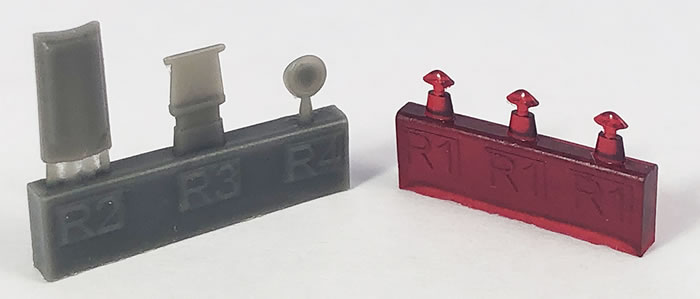
Unusual for a Weekend Edition boxing’s, there are some Brassin Resin parts to further enhance the kits. The MiG boxing provides us with a block of beautifully cast resin aerials and one clear red resin set of lights. A nice add Mr Eduard.
Photo-Etch

You are supplied with a very small sheet of brass photo-etch with 11 parts on it. These are mainly small aerials with separate base plates. Again, a nice touch not normally associated with Weekend boxing’s.
Instructions and Decals
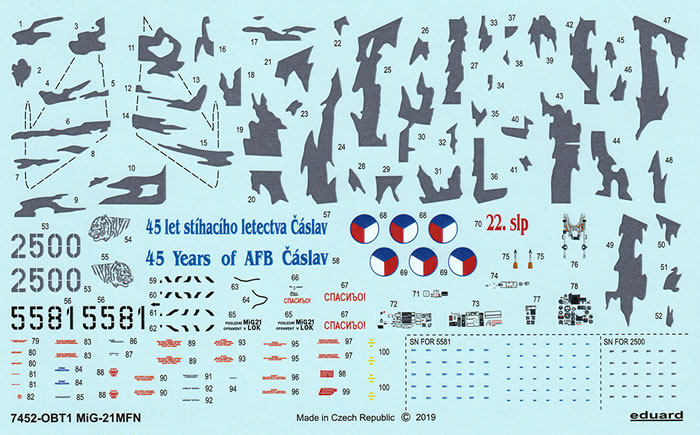
The instructions for the kit are the usual Eduard, with a glossy booklet of 20 A5 pages of high quality detailed instructions, with copious colour call outs throughout, using the Gunze Aqueous, Mr Color as well as the Mission Models range. The decals appear to be in perfect register giving the options for 2 different aircraft. Included is a comprehensive stencil and data on the sheet, with 2 pages at the end of the instructions for their placement as well as a page each for the ordinance stencilling and a whole page for the many pylons and drop tanks.
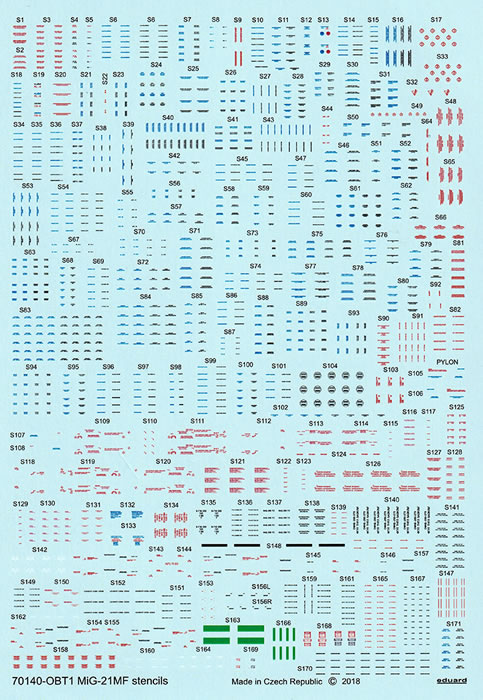
Decals have been produced by Cartograf, so you know they will settle and handle well. Be prepared for several sessions of decaling to get through this pile of decals. For the stencils alone there is approximately 1000 (yes…. One thousand stencil decals) and most are tiny….good luck! I have included a scan of the 2 aircraft profiles but briefly, they are:
-
MiG-21MFN, "2500", 41st Fighter Squadron, 4th Tactical Air Force Base, Caslav, , October 2002 – large Tiger Scheme
-
MiG-21MFN, 5581 ", 211th Tactical Squadron, 21st Tactical Air Force Base, Caslav, July 12th, 2005 – small Tiger markings
Many superlatives have been used about this kit but I think just a simple amazing will do. The detail provided by Eduard is superb, even for a Weekend Edition and for such as small aircraft as is the overall quality of the moulding. With the added Brassin parts and etch, there is basically nothing you need to add for a great build straight for the box. A highly recommended kit set with a great Tiger scheme for one option.
Thanks to Eduard for the sample
Review Text Copyright © 2020 by David Couche
Page Created 27 January, 2020
Last updated
20 February, 2020
Back to HyperScale Main Page
Back to Reviews Page Woo! |
